
The Life and Times of Hubert Brooks M.C. C.D.
A Canadian Hero

 |
|
 |
This web page will provide information about our family's first ancestor in North America, Thomas Rousseau, and also provide information of Hubert Rousseau Brooks who was the ancestor that brought the family back from North Dakota to Canada.
As indicated in section A2.1, Thomas Rousseau seems to have been the 2nd of some 18 "Rousseau family lines" to land in New France and thus North America. He was most certainly a pioneer of the Ile d'Orleans in New France and is considered to be a Québécois "de souche" (old-stock Quebecer).
A good reference for material on Thomas Rousseau is Chapter 1 of the book; Les Rousseau de Pohénégamook by Guildo Rousseau published by des ÉDITIONS DU SEPTENTRION, ISBN 2-89448-468-2
as well as
the Thomas Rousseau GeneaNet Web site
- which I believe obtained most of its information from the book Our French Canadian Ancestors (28 Volume Series) By Thomas J. Laforest Published by Lisi Press, Palm Harbour,
Florida; Thomas Rousseau is featured in Volume 13 Chapter 12 p 183.
Interestingly, on June 18, 2012, there was a feature on Famille Rousseau on the French HISTORIA channel for L'aventure francaise series. The program, produced by Winnipeg based Les Production Rivard, had a segment dedicated to
Thomas Rousseau and discussed the puzzles as to his; place of birth, date of arrival in New France, his religion, and his place of death. His marriage and ever increasing land holdings were also highlited.
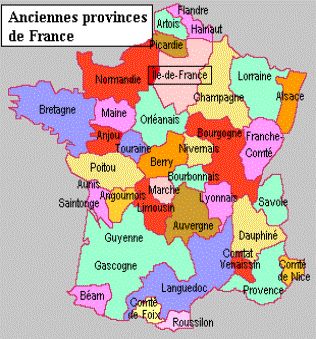
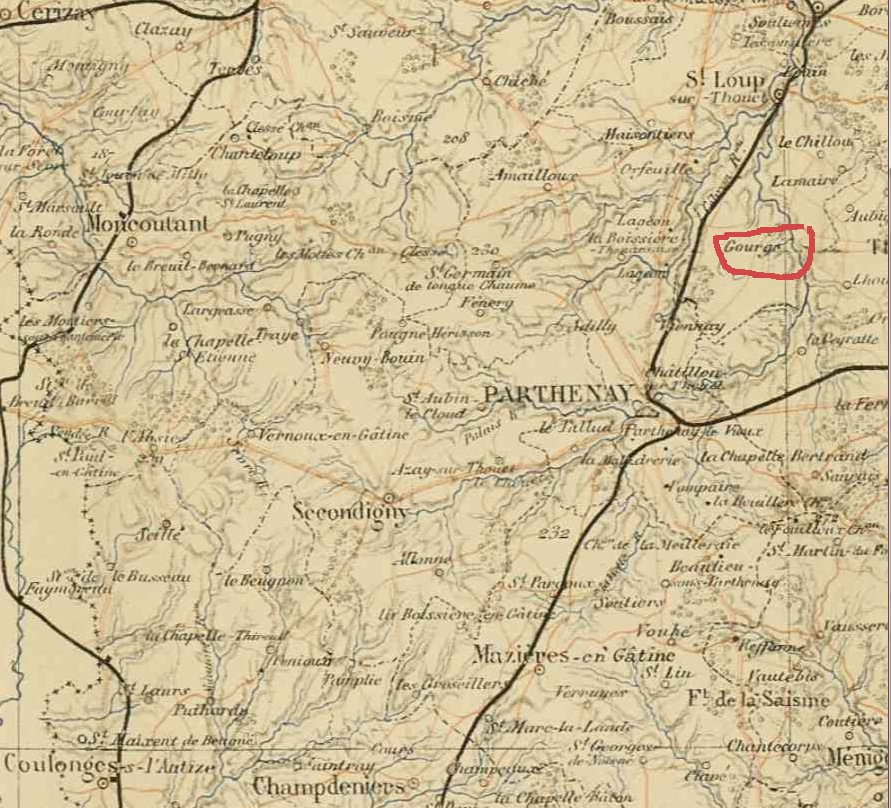
Rousseau family geneaology specialist, Guildo Rousseau, in an article published in the journal; The Ancestor (Vol. 35, No. 285, Winter 2009, p. 141-147), the Genealogical Society of Québec, states that genealogical information circulating for decades about the dates and places of birth and burial of his ancestor Thomas Rousseau are NOT based on any real historical source. No birth or baptismal or any other official document has been traced so far in France which would show that Thomas Rousseau was born about 1632 (the commonly stated year of birth) in Gourgé, or in the nearby village of Oroux - both part of the department of Deux-Sèvres, Poitou-Charentes region, and both being located some 50 km from the city of Poitiers in the south western portion of France.
With regard to Thomas Rousseau's date of birth, Thomas himself seems to have (?intentionally?) confused the situation.
With no official records found in France and these conflicting birth dates, it is impossible to state with precision Thomas' date or place of birth.
Rousseau geneaology specialists believe that Thomas was born and lived in either Gourgé or in Oroux
- but not elsewhere.
The basis for this are the (different) places of birth identified in
the civil and the church marriage contracts. As will be seen, the contents of the civil marriage contract
with Madeleine Ollivier - with Gourgé implied as the birth place - is held by most Rousseau experts as the most important historical document of all- trumping even the Catholic church's marriage contract which
contains the contradictory information of Oroux being the place of birth.
However, even here the wording of the marriage contract entries is (perhaps intentionally) tricky. The exact wording states that Thomas' parents are from Gourgé and Oroux respectively. Although they might on the face of it
imply to the casual reader that Thomas was born
at these locations, the documents do NOT specifically state this!
The small village of Gourgé dates back to the Gallo-Roman period. The Roman built road linking Poitiers and Nantes crossed the river Thouet on whose banks is located the town of Gourgé.
Located some 10 km from the city of Parthenay and about 50 km from Poitiers, Gourgé is essentially a rural community numbering approximately 900 inhabitants in modern times, and reflects the very old architectural
heritage of the town.
The marriage of Madeleine and Thomas was held on Wednesday, October 5, 1667 at Notre-Dame de Québec. The wedding ceremony was celebrated by the parish priest Henri de Bernières who would write the "official transcript" of the marriage ceremony into the church register.
THE ISSUE arrising is that the biographical information entered into the church register by priest de Bernières is significantly different from the marriage information entered into the civil register 6 days earlier by notary Gilles Rageot and witnessed by Thomas and others.
On this later point, of the place of birth changing over a 6 day period from "Gorgé" to that of "Arerou" the names are so completely different that we can NOT discount the entries as one of "consonance" - of incorrectly writing a word based on what one has heard.
The entry of Gorgé in the civil register is similar enough to Gourgé in every way and can be reasonably explained away.
However, historians have NOT found any town, municipality or parish in the diocese of Poitiers for that time with the name of "Arrou" or "Arerou".
Two schools of thought have evolved over time with various Rousseau genealogists regarding the name of "Arrou" or "Arerou".
First, apparantly at the time of Thomas Rousseau there was a small town called Arrou which was - and still is - a joint department of Eure-et-Loir, situated some 22 km from the
town of Châteaudun, located in the parish of the diocese of Chartres. Was this the place of birth of Thomas Rousseau? Certainly, many families with the surname Rousseau
lived in this region of central France, where there are large cities as Chartres, Châteaudun, Dreux and Nogent-le-Rotrou.
It is possible that this is the birth place, but no historical records have been found to indicate that Thomas was born here either. This is especially strange IF Thomas was a Catholic with
the meticulous records maintained by the church at that time.
Second and alternatively, with succeeding generations of genealogists (for example see Genealogy of Canada Web site or Genealogy of French in North America Web Site ) the alleged birth place name of "Arrou" or "Arerou" has become first "Arrochar" - still somewhat faithful to the text of Father de Bernières, and then in later years has became "Oroux" which is the name of an actual small town, also in the diocese of Poitiers, located some 12 km from Gourgé. Again no church or civil records to validate this have been found.
On this point of confusion over the place of birth the conspiracy theories have started. Where is "Arerou" and why did it come into existance? Was it Thomas Rousseau who gave the name "Arerou" to the priest de Bernières to intentionally confuse his past (similar to the multiple birth dates provided by him over the course of time)? Or did priest de Bernières simply not remember the place of birth stated by Thomas Rousseau and incorrectly entered the name "Arerou" into the church register? Was Thomas intentionally misleading the priest de Bernières to "hide" a Protestant past in Gourgé? Some sources indicate that Thomas was a persecuted Protestant back in France and this was one of his reasons for venturing to New France and disguising his past. The movement of Protestants to New France in those early days was restricted and watched very closely by the authorities. Alternatively, was there some other run in with the Catholic church in Gourgé by Thomas or his family that he was trying to hide?
The mystery surrounding the date and place of birth of Thomas Rousseau remains unsolved. Oroux however has become quite common as the identified place of birth of Thomas Rousseau on a number of geneaology web sites. HOWEVER, the civil register sworn in front of notary Gilles Rageot is taken as the more significant document and thus Gourgé is assumed as the place of birth of Thomas Rousseau.
The same uncertainty exists regarding the date and place of burial of Thomas Rousseau. Many genealogy documents state that Thomas Rousseau was buried July 26, 1716 - or before or after this date - at the Hotel-Dieu de Québec, and rests in the cemeteries of the parishes of Saint-Pierre-de-la- Rivière-du-Sud or St-Thomas-de-Montmagny. But nothing is further from the truth. The designation of this false date of death and the false burial place of Thomas Rousseau rests on a misreading made, for the eighth child of Thomas Rousseau, who suffered a disability and was placed in the hospital hôpital de l'Hôtel-Dieu and later died on July 26, 1716.
Finally, according to Guildo Rousseau, his ancestor Thomas Rousseau would probably have died between April 10, 1709 and July 23, 1715, or more precisely between May 24, 1712 and July 23, 1715. But no act of burial has been traced so far to confirm either of these dates, nor the exact place of burial in Québec!

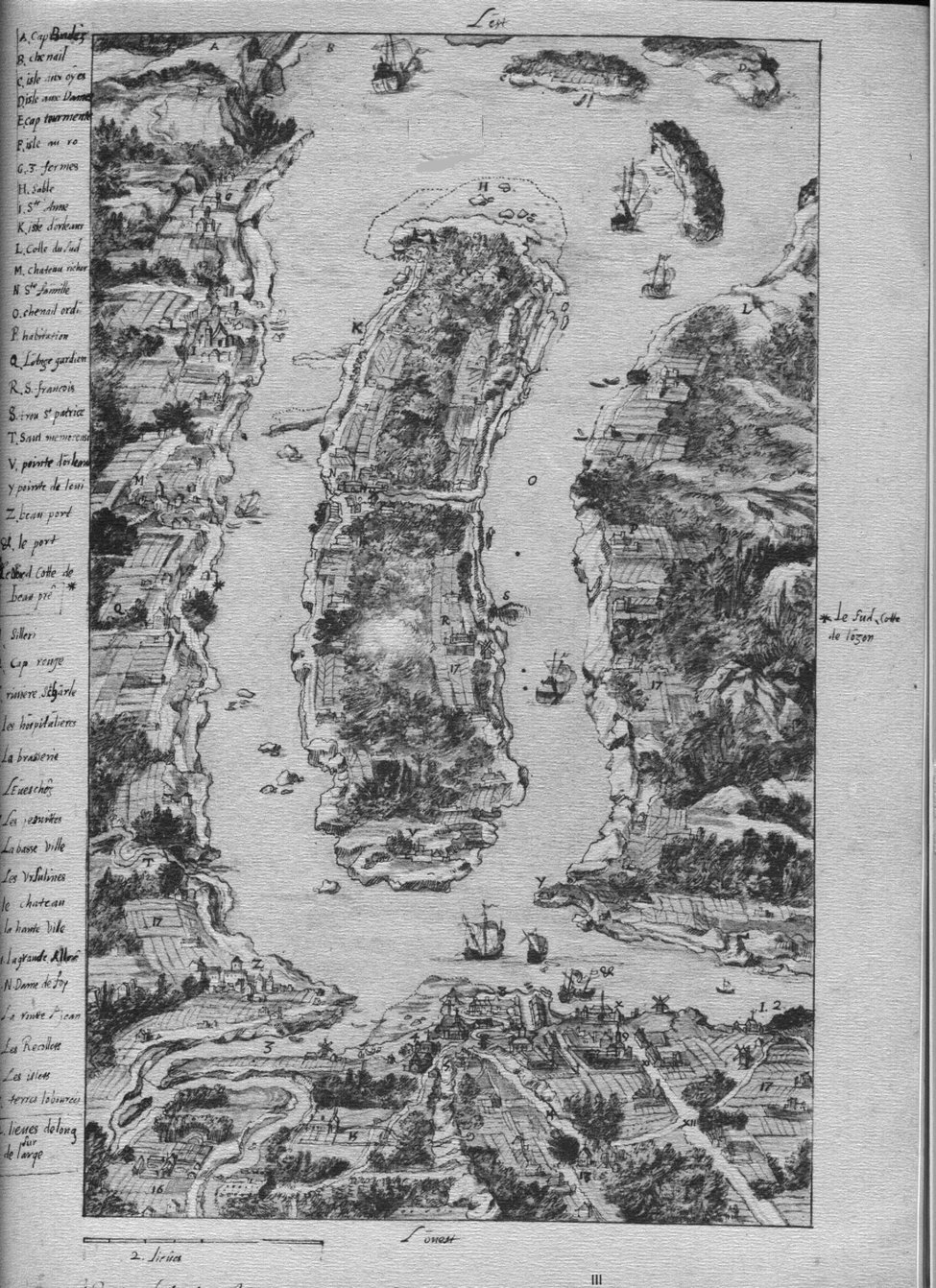
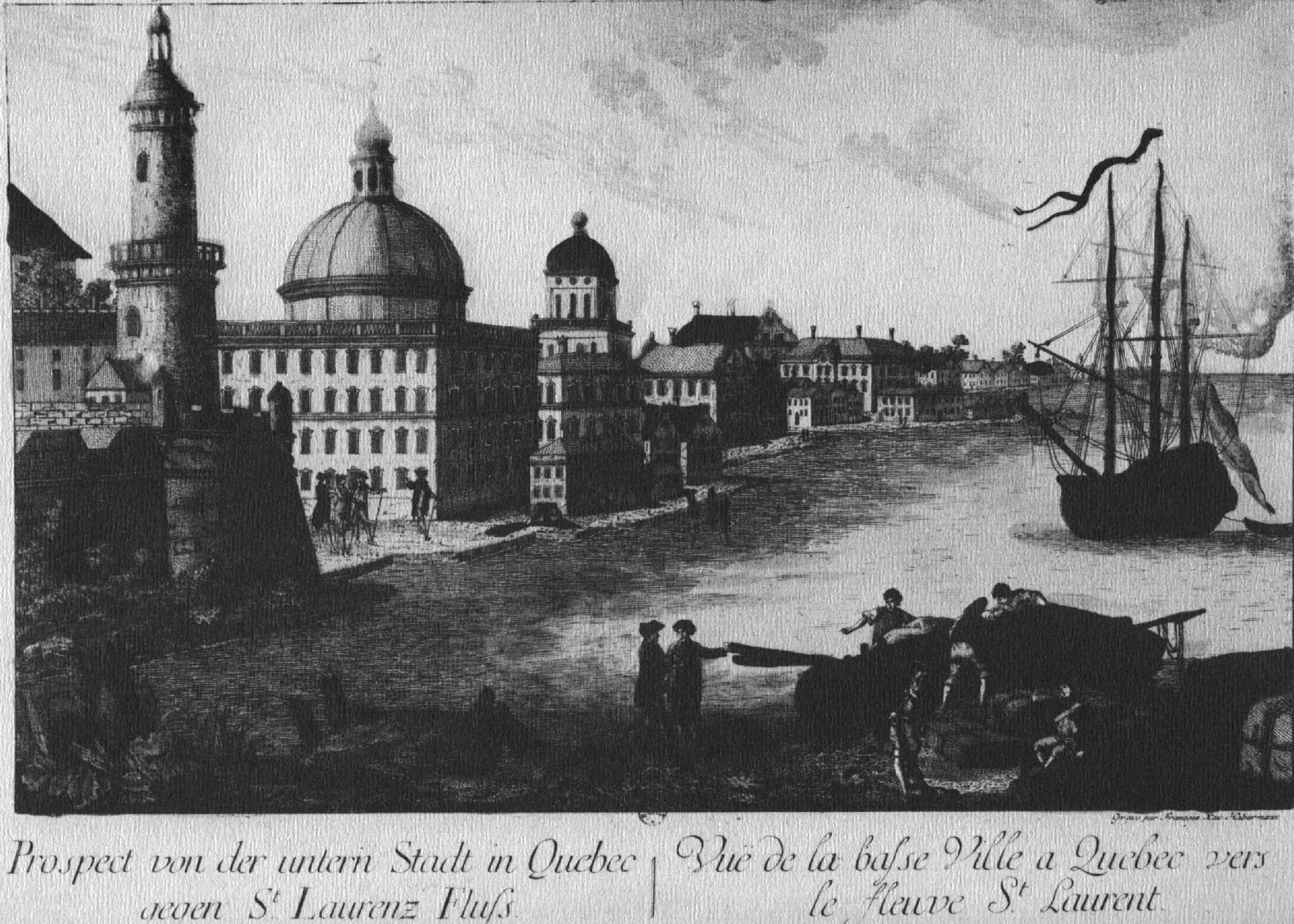
Thomas Rousseau is thought by Rousseau geneaology specialists to have arrived at the port of Québec (New France) during the summer or fall of 1663, after a
long and dangerous journey that took him from the French seaport of La Rochelle. Like all sea voyages of those times, the passage across the Atlantic ocean was not easy.
More than 150 people were typically crowded into the tween-deck space of the ship, where they lived an animal existance for two or three months. Salted meat, wormy hardtack and putrid water were their daily nourishment.
Mal-de-mer was the least serious of many illnesses that most travellers faced.
(NEW FRANCE at that time encompassed; Canada (the St. Lawrence Valley), Acadia, the Pays d'en haut (the Great Lakes) and Louisiana (the Mississippi Valley).)
Thomas Rousseau's name has NOT been found on the passenger lists of the ships sailing from La Rochelle to Québec. Did Thomas travel under an assumed name to "escape" a situation in France? It is known that a few ships travelling late in the season did not venture as far down the St Lawrence as Québec City / Ile de l'Orleans but instead unloaded passengers near Tadoussac and a boat then brought them to Ile d'Orleans. Possibly, but these settlers were still inventoried - unless of course Thomas somehow slipped through. The mystery persists.
The records of trans-Atlantic crossings at that time and Répertoires des équipages et passagers des origines à 1699 are remarkably intact. The ship Le Taureau "Thoros" de la Ville de La Rochelle which departed La Rochelle on May 10, 1663 and arrived in Québec on July 27, 1663 had 3 passengers from Poitiers/ Parthenay one of who was named Jean Thomas. If the Rousseau historians are correct as to the approximate date of arrival, was Jean Thomas our Thomas Rousseau?
One can only speculate as to the REASON that Thomas Rousseau immigrated from France to Québec. Because of the harsh winters, short growing seasons, wars with the Iroquois and slow economic development, Canada was never perceived in France as an "El Dorado". However, what the colony offered was a seigneurial system of land tenure which held the carrot of eventual land ownership, and thus ongoing development for the colony, in return for a period of a number of years of being a "hired man" to a seigneur. Since most immigrants to New France were generally from modest circumstances, the appeal of eventual land ownership and "the hope of earning a better living" was inducement enough for many to leave "sweet France" and endure the long, difficult crossing with a 5 per cent risk of death and landing in a country with immense forests, harsh winters and, what's more, peopled with formidable indiginous warriors! The other possibility of course, is that Thomas was escaping religious persecution in France for being a Protestant.

|
HISTORICAL BACKGROUND on SEIGNEURIAL SYSTEM
From the beginning of the Québec / St Lawrence Valley colony in New France, there ran in the minds of French officialdom the idea that social order should rest upon
a seigneurial system.
Here in the midst of an unfathomed wilderness of New France was a small European settlement with hostile tribes on every front.
Under this system, the lands were arranged in long narrow strips, called seigneuries, along the banks of the St. Lawrence River. Each piece of land belonged to the king of France and was maintained by the landlord, or seigneur.
The seigneurial system was introduced because the St. Lawrence River was something like the "Highway of New France". The river provided water and a means of transportation, which enabled settlers with land along the St. Lawrence to be successful. Land along the river, therefore, was much in demand.
The seigneur divided the land further among his tenants, known as censitaires or habitants, who cleared the land, built houses and other buildings, and farmed the land.
The habitants paid taxes to the seigneur called cens and another inheritance tax called lods and ventes. The habitants would also divide their land for their children once they had families of their own.
Five things that the Seigneury had to do:
Five things the habitants had to do:
The seigneurial system of land tenure was basically a system whereby the local seigneur or landlord gave to a "censitaire" or tenant a surrounding property for which the tenant would develop the land and pay heavy dues each year for a defined period of time -- usually 3 years -- as well as on condition of aid to the colony in time of conflict; and in return the seigneur would eventually vest outright land ownership to a piece of (possibly different) land to the tenant.
There was thus a "win-win" inter-dependancy which developed between the colony powers-that-be/ the seigneurs and the "censitaire" or tenants which led to social
order and security within the colony.
See for example web link
SEIGNEURS, FIEFS ET SEIGNEURIES DU QUÉBEC for further information -- note: Thomas Rousseau would have dealing with Jean-Baptiste PEUVRET du MESNU.)
Thomas Rousseau was probably 31 or 32 years of age when he landed in Québec. This is the age that Thomas Rousseau gives 23 March 1664, during the
Ceremony of Confirmation .
(Ref: Hubert Charbonneau and Jacques Légé, Directory of baptismal, marriage, burial and Census of Former Quebec, Research Program in Historical Demography (PRDH), The University Press
of Montreal, 1980, vol. 6: "nominative censuses and other documentation.")
Nothing is known of Thomas' prior life in France - or for that matter of his father Honoré Rousseau. What was Thomas' ancestoral family history? Was it from one of the many lines of Rousseau who have distinguished themselves in the history of France? Were the Honoré/ Thomas Rousseaus farmers? seamen? artisans? traders? notables? It is unfortunately NOT known what the occupation(s) or pedigree of this branch of the Rousseau family was in France.
However it is an undisputed fact that Thomas appears to have some level of education and appears more educated than the average Frenchman who came to populate Canada in the XVII century. He can write his name and the signature that he affixes to numerous contracts that still exist for public viewing shows a firm and nicely molded signature with a "flourish" stroke -- often then the mark of a "quality upbringing".

Since Thomas only signs his contract as a hired farmer after arriving in Québec, it would seem that he was able to pay his own passage to New France - so he had some modest means. Some historians have speculated that perhaps Thomas was running away from a situation in France given the elusive nature of his birth date and place. Further, Thomas seems to adapt quite readily to his activity as a hired farmer which suggests that he has had prior experience in this endeavor.
On 23rd March of 1664, Thomas obtained the Sacrament of Confirmation from the Bishop of Québec, Bishop Laval. (The Roman Catholic Bishop of Québec ruled the colony until Jean Talon was appointed Intendant in 1665.) Historical records indicate that one hundred and three other people, most likely new emigrants like Thomas, were also confirmed the same day. The ceremony was mandatory. It allowed the Catholic religious authorities of the time to assure that the inhibitants were Roman Catholic, and if not to co-op mainline Protestants into an act of Catholic worship. Had a new inhabitant not agreed to go to the ceremony, he would have drawn the attention of the authorities to himself, potentially exposing himself to repressive measures, or to be simply repatriated to France on the next ship. Because of the seemingly elusive nature of Thomas' birth date and place, historians have questioned whether Thomas was a Catholic, perhaps he was a Protestant or Calvinist. Regardless, he was smart enough to realize that IF he wanted to stay in New France, and to fullfill his dream of owning land, he had to partake in the ceremony.
The 1666 CENSUS of Québec taken February / March of 1666, indicates that there were a little more than 3,200 people in the colony, not including the 1,100 or so soldiers in the Royal troops.
The whole of the clergy comprised one Bishop, eighteen Priests and ecclesiastics, and thirty-one Jesuit priests and brethren.
(Editor's Note: I have yet to find Thomas' name in the
1666 CENSUS of Québec . Jean Talon was in charge of the first census of New France and used the de jure principale that is, counting people where they normally reside.
He did much of the enumeration himself, going door-to-door. Although the CENSUS was geared more to FAMILIES, single residents of the colony were also enumerated. It is thought that Thomas was working for
seigneur Jean-Baptiste Peuvret du Mesnu at this time and so perhaps was missed.)
On July 14, 1666, Thomas enlisted as a hired farmer for a five year period, to the landowner Jean-Baptiste Peuvret du Mesnu of Gaudarville for a piece of land on the southwest side of the
island of Orleans.
(The seigneur Jean-Baptiste Peuvret du Mesnu had been in the country since 1651, and early on became secretary to Governor Jean de Lauson before becoming a notary, then clerk of the Senechaussee.
In 1663, the Sovereign Council made him its first clerk and secretary, a post that he occupied until his death in 1697. On March 12, 1661, Peuvret de Mesnu acquired a concession of twenty arpents of frontage on Ile d'Orleans granted
some twenty years earlier to Noel Jechereau des Chastelets. )
The employment contract stipulated that Thomas must attend to "five acres of arable land along with a large house, barn, stable, yard, garden and other amenities�. Thomas was to be provided with two great oxen and Thomas was to deliver 80 bushels of wheat and 25 bushels of peas each and every year. Finally, the Agreement detailed further obligations that Thomas must meet: carrying wood, wintering horses, supplying butter, sharing the profits from the farms cows, pigs and chickens.
Madeleine Ollivier arrived in Québec September 25, 1667 aboard the ship Le Saint Louis de Dieppe. See also Répertoire des Filles du roi et filles à marier .
The ship had left Dieppe on June 10, 1667 and stopped over in La Rochelle before proceeding to Québec. On board were 100 engaged ladies (dowry supplied by their families), 90 Filles du Roi ("King's Daughters"), and 15 horses.
Madeleine Ollivier was a so called Fille du Roi ("King's Daughter"). (For example see Madeline Ollivier listed as a Fille du Roi.) She was approximately 30 years old upon arrival, had been orphaned as a young child, and was seeking a new life and husband in New France. The ship's manifest had her listed as "Fille de Jean Ollivier et Louise Prévost de Caudebec-en-Caux,76490; now the capital of the canton of Seine Maritime (located about 35km from the city of Rouen); Haute Normandie (Upper Normandy), France. " Rich or poor, most women did not typically have an occupation as we understand the term today. They were preparing for marriage, which was virtually an economic necessity in an era when a woman alone would have difficulty earning a living. Of the 2,000 female immigrants, over two-thirds were prepared to marry as soon as they arrived - something strongly encouraged by the authorities!
HISTORICAL BACKGROUND ON FILLES du ROI
From the time of the earliest French colonization of Quebec in 1604 until 1663, there were only a handful of families living in that region. The majority of its small population was made up of hunters, trappers, French soldiers, a few explorers, a few priests, and some sailors. France and England, long at odds and in competition with each other, were then attempting to expand their new colonies, to exploit the land and its resources, and to establish stronger and more viable colonies in the New World. In 1629, the population of Quebec, then the only settlement in the present province of Québec, had a resident population of only 21. By 1639, that number had grown to 139 from new settlers and some births. By 1662, the population had increased almost 10-fold to 1,100. By this time, the English colonies in America were growing rapidly. About this time, the French hierarchy decided to adopt a new plan to help establish a stronger and more permanent foothold in its North American colony, which had, by then, expanded to three principle towns on the St. Lawrence River: Québec, Trois Rivières, and Montréal (known as Ville Marie back then).
When Louis XIV took charge of New France in 1663, the report on female departures for Quebec in New France was less than satisfactory. Women then accounted for about one-third of the white population,
and there were seven men for each marriageable French woman. To address such a disastrous situation which held back the settlement of the colony, Louis XIV and his Minister Jean-Baptiste Colbert
sent out to "Kebec" so called Filles du Roi (Daughters of the King), mostly aged between 15 and 30 (the legal age of marriage for girls at that time was 12 years old), to marry bachelors already
settled in the colony. From 1663 to 1673, approximately 850 such women suitable for marriage reached Canada. (
Filles du Roi Link 1
and Filles du Roi Link 2
and Filles du Roi Link 3
and Filles du Roi Link 4)
(Next to the Province of Ile De France (containing Paris) at 314, the French Province of Normandy (where Madeleine originated from) provided the second
most of the Filles du Roi at 153 -- Poitou, the Province where Thomas originated from provided 38 Filles du Roi.)
The "Kings Daughters" were to receive a dowry of one hundred livres (ten for personal and moving expenses, thirty for clothing and sixty for passage).
(One hundred livres was a substantial amount of money in those days. For example, a common laborer would have to work almost a year and a half to make such a sum and a surgeon made from 100 to 150 livres a year.
Thus, many orphaned girls saw this as an opportunity for adventure, money, marriage, and getting out of the deplorable orphanage situation they found themself in. )
Included also was a hope chest filled with necessities such as: one headdress, one taffeta kerchief, one belt, shoe ribbons, 100 needles and one thimble, one comb, white and grey thread,
one pair of stockings, shoes, one pair of gloves, scissors, a thousand pins, one bonnet and laces. Historians claim that less than ten girls actually received the promised dowry.
The estimate, including the "Kings Daughters", is that four thousand eight hundred and ninety four of these adventursome girls, some as young as 16, arrived from 1608 to 1700 in New France.
Although the authorities at the time vehemently denied it, a number of historians claim that the reality of the times was that a large number of the early young ladies, Filles du Roi, were gathered from the streets of Paris and other towns. The program was to sweep clean the streets of homeless women, female criminals, prostitutes, orphans and the poor who were gathered up for export to New France. Other historians take the view that a majority of Filles du Roi were robust single girls of good character - some who were gathered from the orphanages. (As it turned out, the preferences of the men was for peasant girls, the plumpest girls were considered first, farm girls were preferred over town girls.)
Under French law, in those days, a wife's status was pretty much like that of a chattel (a piece of property). It was almost impossible, for instance, for a wife to regain her freedom after marriage. Even if there was infidelity on the part of a woman's husband, this was not an excuse for a woman to seek freedom. A woman's only defense was if her husband beat her with a stick thicker than his wrist; then, she was given the right to separation or divorce. The local Indians were aghast at this attitude of the colonists to women -- givers of life.
The Filles du Roi had the privilege of refusing or accepting who they wanted. It is reported that the girls asked their suitors questions like:
"How many live in your house?";
"Do you have a good hearth (fireplace)?";
"How many cows and chickens and horses do your have?";
"Are you clean in your habits?";
and "Have you a proper bed and plenty of blankets?"
As mentioned above, the Filles du Roi were part of King Louis XIV's program to promote the settlement of his colony in Canada. The Filles du Roi married soon after their arrival in the colony, thereby becoming founding immigrants. Some 737 of these women married and the resultant population explosion gave rise to the success of the colony. Most of the millions of people of French Canadian descent today, both in Québec and the rest of Canada and the USA (and beyond!), are descendants of one or more of these courageous women of the 17th century. All Québécois de souche (old-stock Quebecers) are considered to have at least one Fille du Roi amongst their ancestors.
Madeleine Ollivier arrived in Québec September 25, 1667.
In all probability, Thomas Rousseau, like most other single men in Québec City, monitored quite closely the arrival of vessels from France carrying elligible "Kings Daughters".
It seems that Thomas wasted no time in picking out Madeleine and the couple-to-be agreed upon a quick marriage as desired by the French authorities.
For 5 days after her arrival, on Friday September 30, 1667, Madeleine accompanies Thomas to the CIVIL notary, Gilles Rageot, where both spouses sign a multi-page marriage contract defining the joint communal marriage rights.
Thomas, who was hardly wealthy at the time, presented Madeleine with a dowry of 50 livres. Like most of the Filles du Roi at that time, Madeleine does not have a dowry to offer the communal marriage contract. Despite the modest assets of the couple, the marriage attracted the attention of some of the most prominent members of Québec society including: the Intendant Jean Talon, Barbe de Boullogne; J.B. Gaudon, sieur de Belle Fontaine; and Marie-Catherine Nau, wife of Jean-Baptiste Peuvret for whom Thomas worked as a hired man for over a year on a concession located on the southwest side of the island of Orleans.
Six days following the civil marriage contract signing ceremony, on Wednesday, October 5, 1667, Thomas Rousseau married Madeleine Ollivier at Notre-Dame de Québec Catholoc Church. The wedding ceremony is celebrated by the parish priest Henri de Bernières. An image of the entry into the church registry is shown below.
See section A3.1 above for DIFFERENCES in information provided on CIVIL and CHURCH marriage entries.

|
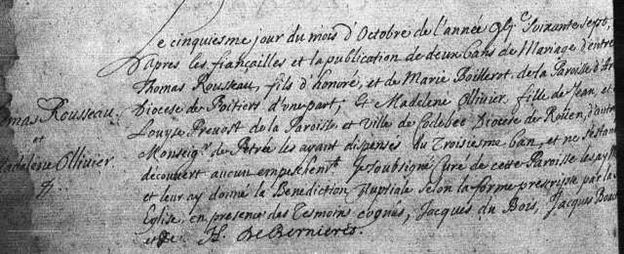
|
Although the 1666 Census completely ignored Thomas Rousseau, he is mentioned in the fief census which the vassal de Mesnu drew up for his Lord, the Bishop and Seigneur Msgr. de Laval. This document was recorded in the June 9,1668 notes of the notary Rageot. It says that,Thomas Rousseau worked a piece of land with three arpents in frontage, whose depth reached to the road which bisects the Ile d'Orleans. He paid "60 sols and three live capons in seigneurial rent".
In the 1681 CENSUS of Québec (click on REC1681.ZIP after reaching link to access Census), the following information was provided about Thomas Rousseau's family at that point in time (census nominally taken on March 30, 1861.)
| No | LIEU | NOM - Homme | PRÉNOM - H | FONCTION | Age-H | NOM - Femme | PRÉNOM - F | Age-F | Age-E1 | Age-E2 | Age-E3 | Age-E4 | Age-E5 | Age-E6 | Age-E7 |
| 2622 | C. St-Laurent(île d'Orléan) | Rousseau | Thomas | 55 | Olivier | Madelaine | 44 | 13 | 11 | 10 | 7 | 7 | 5 | 1 |
NOTE for TABLE Header: Homme or H = Man; Femme or F = female, E or Enfant = Child
Thomas Rousseau had been living on the Île d'Orléans for approximately fifteen years. The land he occupied was the same as in 1668 and was found to be located in the parish of Saint-Paul
(now Saint-Laurent) on the island of Orleans.
The land he was cultivating was about two to three acres of frontage on the St. Lawrence River with about 36 acres of depth (fifteen arpents) (1 arpent is approx 189 feet).
Thomas owned a gun and had four head of cattle. Seven of the eight children born so far were living with their parents.
Over a length of
approximately 44 acres (or about 2.56 miles) of water frontage ,
were located a dozen Ile d'Orleans founding families (Bouffard, Dubois, Gosselin, Maranda, Christmas, Rousseau, Salois, Sivatier, etc ) of the parish of St. Lawrence Island of Orleans.
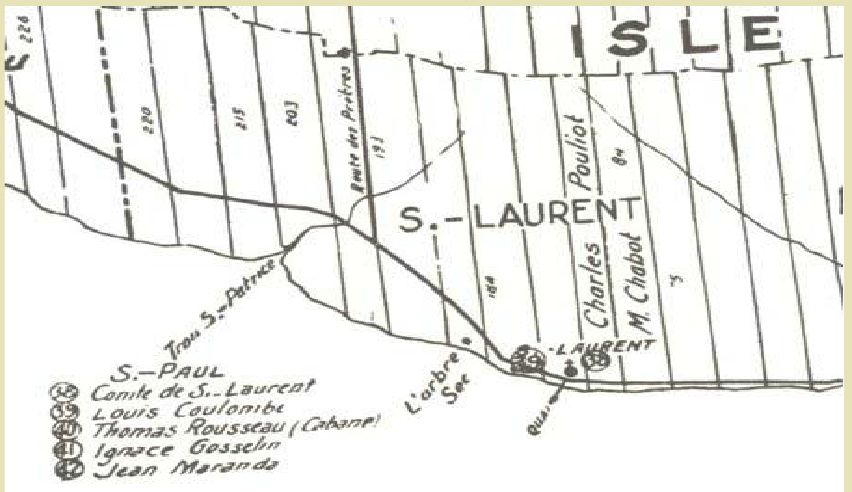

|
The families identified in this 1681 census in the neighborhood of that of Thomas Rousseau are those with whom he and his family and his descendants would have multiple relationships including marriage, exchange and sale of land plots and so forth weaving linkages between these families from the 1660s until the mid-nineteenth century.
|
|
On Friday, April 21, 1690, Madeleine Ollivier Rousseau died. After 18 years of marriage and 11 children Madeleine died at the age of 55. As a "Fille du Roi", she had amply filled her role as a wife and mother. She had her last child, Jean-Baptiste, at the age 44. Her funeral service was conducted the next day at the church in Saint-Laurent by the priest Jean-Marie Tremblay.
Thomas Rousseau had 11 children (see Section A2.1) with his first wife, Madeleine Ollivier, and a twelfth through his second marriage, with Francoise Charlotte Belanger.
The family consisted of 6 boys and 6 girls.
The sons were; Pierre and Martin (twin brothers), Thomas, Antoine, Jean-Baptiste and Guillaume.
The six daughters were; Anne-Marie-
Catherine, Marie-Madeleine, Geneviève, Marguerite, Marie and Louise.
Two of the six girls died in infancy: Marie-Madeleine, at 16, and Marie at one year of age.
The other four girls married and lived with their husbands in the seigniory of Rivière-du-Sud, today called the parish of Saint-Thomas and parish of Saint-Pierre-de-la-Rivière-du-Sud, of the county Montmagny.
With respect to the twin boys; Pierre, the twin brother of Martin, died September 8, 1684, at the age of 11 years. Martin,had better health and and setled in L'Islet where at age 27 married Marie-Élisabeth Thibault on March 3, 1700. Marie-Élisabeth was already the mother of four children from her first husband Jacques Bélanger. Martin took over the cultivation of land that Marie-Élisabeth inherited from her late husband. As such Martin was one of the first inhabitants of the parish of Notre-Dame-de-Bonsecours at L'Islet. Martin and Marie-Élisabeth would have a further 7 children together. The date and place of Martin's death and burial are still unknown to this day.
Two of Thomas' other sons would not have children.
On July 26, 1716, at the age of 34, Thomas ("Jr.") was placed in l'Hôpital-Général de Québec by his brothers and sisters.
(The "malady" was not stated but mental health issues is suggested. Both of the parents were dead by this time.)
Thomas' son Guillaume,
from his second marriage, would die at the age of 21 on July 22, 1715 at Château-Richer.
Antoine would have 11 children with his wife Anne-Catherine Bouffard.
The line of offspring from Thomas Rousseau's son Jean-Baptiste will lead ultimately to Hubert Rousseau Brooks and then to Hubert Brooks of this biography.
Jean-Baptiste Rousseau married Catherine Rouleau Sansoucy on May 23, 1712. The couple would have seven children together (see A2.1)
He owned six acres of land on the SEIGNEURIAL territory of Rivière-du-Sud. Also located on this territory were his sisters Anne-Marie-Catherine,
Geneviève, Marguerite, Louise, and their respective husbands Simon Fournier, Jean-François Langlois, Pierre-Noël Morin-Valcourt et Jean-Baptiste Proulx all of whom had been
cultivating land there for a number of years. In fact Jean-Baptiste's land was between that of his brother-in-law Simon Fournier on the northeast side, and that of his brother Martin Rousseau on the southwest side.
Jean-Baptiste was able to acquire this land as a result of the inheritance of his wife Catherine Rouleau Sansoucy .
The map below shows the location of Jean-Baptiste's land and (shaded area) of that of his other brothers and sisters.
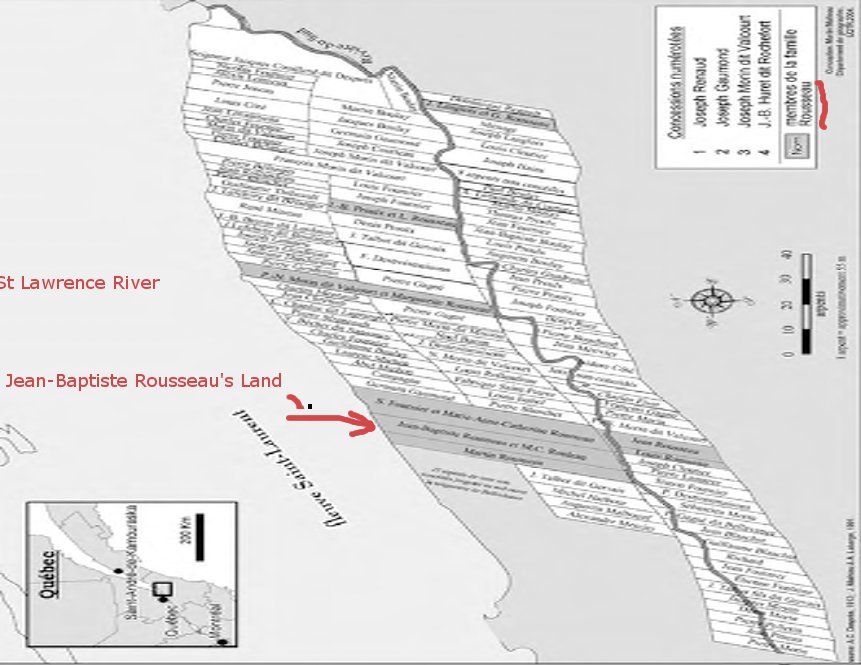
During his life Jean-Baptiste was quite active in real estate transactions in the Québec City area.
As did his father Thomas, Jean-Baptiste would marry twice. (This pattern of re-marrying would be quite common in the history of the Rousseau clan.) Jean-Baptiste remarried, November 17, 1737, to Madeleine Des Troismaisons dit Picard de Montmagny. Jean-Baptiste and Madeleine would have 8 children together. Thus Jean=Baptiste had a total of 15 children on his land on Rivière-du-Sud.
It was a little less than one year and 2 months before Thomas Rousseau re-married. His new-wife-to be was Françoise-Charlotte Bélanger, widow of Jean Langlois dit Boisverdun, who had died some years earlier on August 25, 1687. Françoise-Charlotte resided on the land immediately opposite Thomas', on the other side of island of Orléans. (Françoise-Charlotte hadhad 7 children from her marriage to Jean Langlois.) With the Rousseau family on one side of the island and the Langlois family on the other, it was only a question of time before it became clear that the two families were destined to merge with each other.
On June 21, 1691 Thomas and Françoise-Charlotte signed a CIVIL marriage ceremony in the house of the seigneur Peuvret Demesnu in the presence of the notary François Genable
specifying the terms of the contract of marriage.
The marriage relegious ceremony was then celebrated on July 4, 1691 at the Saint-Pierre Catholic Church.
Over time, Thomas Rousseau would become a substantial land owner on the island of Orléans. On June 30, 1704, when Thomas was approximately at the age of 73, he sent a letter to the notary Florent de La Cetière of the parish of Saint-Laurent of the island of Orléans, making his second wife, Charlotte Bélanger "joint steward" of his businesses to manage, sell, hire, rent and do everything she sees fit to move the business forward. This makes sense as Charlotte Bélanger was much younger than Thomas and she could very well assist him and act in his name.
The custom at that time for inheritance transfer was a legal process called "la donation" or legacy settlement to one's eldest son. Although son Antoine was the second last to be born, as a result of circumstances described in the earlier sections, Antoine was Thomas' eldest, surviving, competent son.
Thus on October 11, 1707, Thomas signed a multi-page document in front of the notary Louis Chambalon witnessed by the baliff Jean Meschin and the shopkeeper Estienne Dulong providing a "donation" or legacy settlement to his son Antoine, then aged 23. Signatures of Thomas, Jean Meschin, Estienne Dulong and Louis Chambalon are affixed to the end of the document.

The document introduction states that because of Thomas' "advanced age" (Editor's Note: More on this latter) and his inability to provide for himself, he wishes to make "la donation" to his son Antoine with the proviso that Thomas continues to receive a pension that will sustain him in sickness and health for the rest of his days, that Antoine will fullfill all obligations for the lands including payment of 30 sols and one and a half hundred chapons per year to the seigneur of the premises, and pay Charlotte Bélanger the rent for her dowry for the time that she may survive Thomas, and finally pay for the burial of Thomas and then pray for the salvation of his soul by celebrating 10 low Requiem Masses.
The "donation" provides half of his assets to his son Antoine, with whom Thomas will continue to reside, and the other half going to his other children from his first marriage to Madeleine Ollivier.
One surprising statement in the "donation legal document" is that it asserts that Thomas' advanced age as of October 11, 1707, is ninety-eight years old! This seems surprising given the other birth dates provided by Thomas in prior legal documents and census inputs. Did notary Louis Chambalon perhaps mis-understand Thomas on this point, or was Thomas simply confused at his now "advanced age", or did Thomas intentionally mis-lead the notary? Again we do not know the truth as to Thomas' actual birth date. His signature on the legal "donation" document remains "firm".
|
As mentioned in an earlier section, the DATE and PLACE of death of Thomas Rousseau is NOT known. There has been some confusion amongst geneologists with the death of Thomas' son Thomas Rousseau (Jr.) on July 26, 1716. This is NOT the date of death of Thomas Rousseau the husband of Madeleine Ollivier and Françoise-Charlotte Bélanger. How long after the October 1707 Legacy Settlement Transfer to son Antoine did Thomas Rousseau live? It is clear that Thomas Rousseau was still alive April 9, 1709, as he signed the church register for the marriage of his son Antoine to Anne-Catherine Bouffard at St. Lawrence on the island of Orleans in the presence of priest Francois Poncelet. With firm handwriting, Thomas Rousseau along with Anne-Catherine's father Jacques Bouffard signed the church wedding giving their mutual consent to the marriage ceremonies. The l'Ile d'Orléans map produced by Sieur de Catalogne circa 1709 shows Thomas Rousseau's property in the St. Laurent section of the island (see adjacent map with green hiliting). (It is NOT known when in 1709 this map was produced OR if Thomas was still alive, although it is presumed that Thomas was alive in 1709 as a result of this map.) EDITORS NOTE: The Ile d'Orléans is approximately 75 kilometers/40 miles in circumference. Almost all plots went from the shore to the center of the island in a North-South direction. The island was divided into approximately 200 parcels. The plots on the island were grouped into larger sections named St-Pierre, St-Laurent, la Ste-Famille, St-Jean, Argentenay and St-Francois. However, after April 9, 1709 it is not verifiably certain whether or not Thomas was alive or not.
As might be inferred, there is some CONFUSION. All that can be said is that Thomas Rousseau died sometime between April 10, 1709 and July 23, 1715, and probably between May 23, 1712 and July 23, 1715. It is remarkable with the detail records kept by the Catholic Church, that Thomas' date and place of death is not known to this day. Did Thomas somehow "plan" this deception to conceal from posterity a past parental alliance that he wanted to keep secret to preserve the reputation of his offspring? The mystery remains. |
|
A grand total of 84 children were produced from the sons and daughters of Thomas Rousseau, the first Rousseau in "our line" in North America.
| NAME - Rousseau Offspring | NAME - Marriage Partner | Children | |||
| Boys | Girls | Died at ChildBirth | TOTAL | ||
| Thomas Rousseau | Madeleine Ollivier | 5 | 6 | 12 | |
| Charlotte Bélanger | 1 | ||||
| ********** CHILDREN of Thomas Rousseau with FAMILIES ********** | |||||
| Anne-Marie Catherine | Simon Fournier | 3 | 7 | 1 | 11 |
| Geneviève | Jean Langois | 4 | 3 | 1 | 8 |
| Martin | Marie-Élisabeth Thibault | 1 | 6 | 7 | |
| Marguerite | Pierre-Noël Morin | 6 | 5 | 11 | |
| Louise | Jean-Baptiste Proulx | 5 | 4 | 9 | |
| Antoine | Catherine Bouffard | 6 | 5 | 11 | |
| Jean-Baptiste | Catherine Rouleau | 3 | 3 | 1 | 15 |
| Madeleine Destroismaisons | 5 | 3 | |||
| TOTAL | 39 | 42 | 3 | 84 | |
Looking back over the space of almost 40 years one can readily imagine that Thomas Rousseau was very pleased with his lot in life and that of his sons and daughters. His sons and daughters had provided him with an impressive number of grandchildren. Having arrived in New France from Poitou essentially pennyless, Thomas continued to work and build on his most valuable asset - the land ( 2.5 acres of river frontage by 36 acres depth - whose depth reaches the road that divides the island of Orleans) that Seigneur Jean- Baptist Peuvret granted him on July 14, 1666. He continued to pay a seigneural rent of 60 sols and 3 chapons. By the time of Thomas' death, he had acquired substantial additional lands on the island of Orleans to bequeath to his offspring.
According to ancestry.com which references the Drouin Collection, the Louis Rousseau and Luce Huard were married in
St–Isidore, Dorchester, Québec on 13 July 1846.
(Note the name ‘Luce’ was mis–spelt as ‘Lun’ in the translation of the written to ancestry.com to
digital records.)
|
|
|
|
|
|
Louis and Lucie Rousseau and there 2 eldest children Louis Albert and Euphrémie appeared in the Canada 1851 Census living in District Name: Dorchester (county); District Number: 7;Sub-District Name: St. Elzéar; Sub-district Number: 92 (page 91).
Schedule B (page 109 line 33) from this 1851 Census showed:

|

|

|

|
On-line geneaology links contain a variety of birth dates for Hubert Rousseau ranging from 1860 to 1863.
Further, I have always found it surprising that Hubert Rousseau Brooks, temporarily had the name John Brooks while in Grand Forks North Dakota as opposed to the more french Canadian name of "Jean". The quest was to find Hubert's given middle name at birth.
To try to settle this,a microfilm of the Records for Paroisse St. Elézar, St. Elézar Cte., Beauce-N,
Québec, Canada were obtained through the Family History Center of Fort Pierce Florida (FHL Film 1,294,573 Registres Paroissiaux
1846 - 1876)
(containing Baptisms, Marriages and Deaths as recorded by the church).
(St Elzéar Church; 672 rue Principale, St Elzéar Beauce-N, Québec, Canada G0S 2J0 ph: 418-387-2830)
The image below, B97 (Baptemes 97) in Section 3 of Microfilm 1,294,573 contains the record for Hubert Rousseau's baptism at the Parish of St. Elézar.
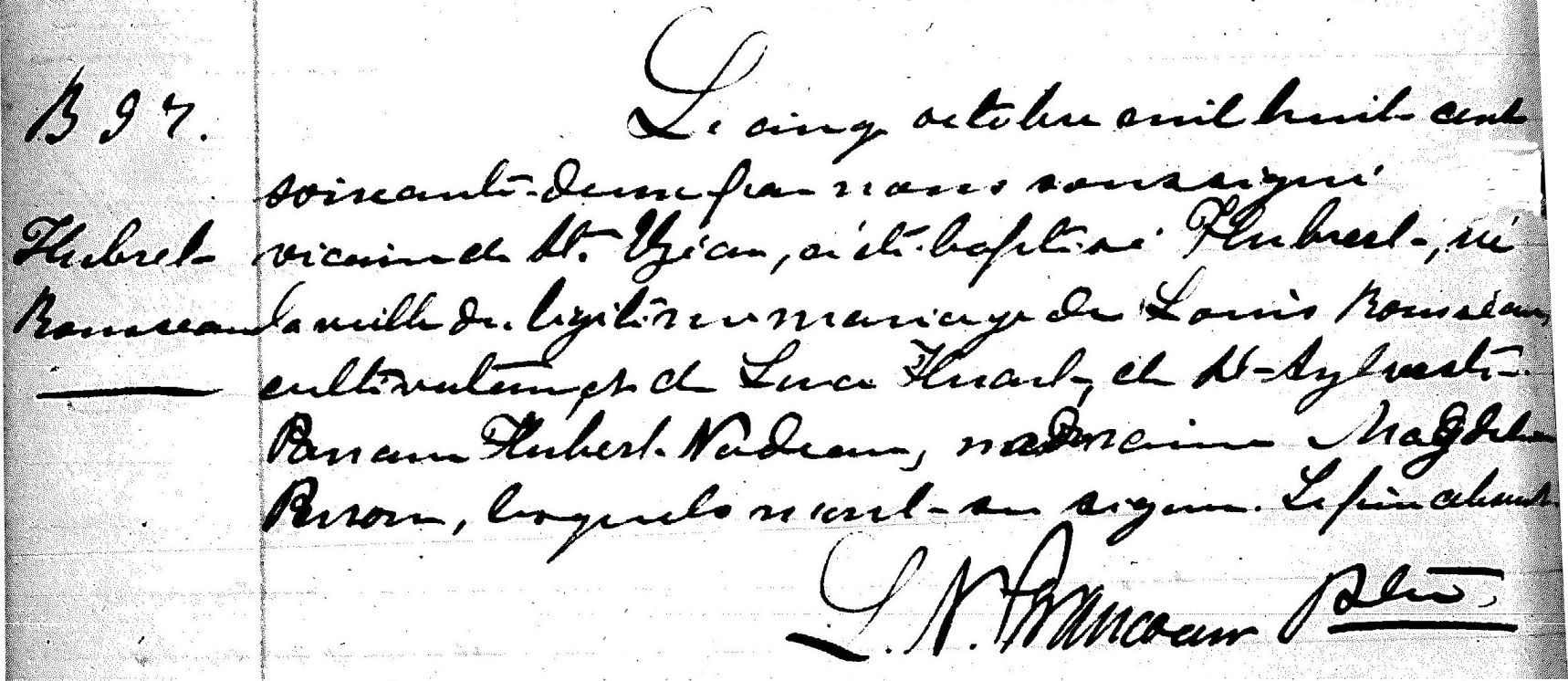
The church record states the following:
"Le cinq octobre mille huit cent soixante deux par nous soussigné vicaire de St Elzéar a été
baptisé Hubert né la veille du légitime mariage de Louis Rousseau cultivateur et de Luce Huard de St Sylvestre.
Parrain Hubert Nadeau, Marraine Magdeleine Perron, lesquels n'ont su sign. Le pere absent.
(signé) L.N. Francoeur ptre"
Which translates into English as (thanks to Hubert Brooks of Boucherville Que for translation):
"On October fifth eighteen hundred and sixty two by we the undersigned vicar of St Elzéar have baptised Hubert,
born the day before of the legitimate marriage of Louis Rousseau, farmer, and Luce Huard of St Sylvestre.
Godfather Hubert Nadeau, Godmother Magdeleine Perron, the latter having not signed. The father absent.
(signed) L.N. Francoeur priest"
Thus the birth date for Hubert Rousseau is determined to be October 4, 1862 (previous day to October 5th), and that Hubert was born in St Sylvestre Québec.
Unfortunately, no middle name is given on the baptismal certificate. One would presume then that the "John" surname that appeared for a short time in Grand Forks was an anglized version of Jean -- but this is speculation.
The map below illustrates the location of Saint Sylvestre just south of Québec City as well as some of the other locations pertinent to the Rousseau family in the DORCHESTER, LEVIS and BEAUCE regions of Quéabec.
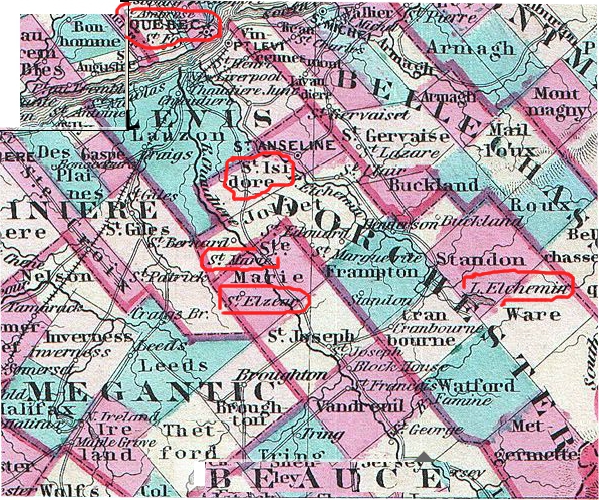

This was the first major CENSUS in Canada of the then existing provinces which most certainly included Québec.
Although there were different names used at the time, there was a "short form" and a "long form" version of the Census. The "short form" or
"Schedule 1 - Nominal Return of the Living" was designed to enumerate the entire population of Canada by name and contained 23 columns.
The name of every individual who lived within an enumerator's district as of April 2, 1871 was to be noted.
As we will see, the Louis Rousseau Family was captured by this Census.
The CANADA 1871 CENSUS records that, as of April 2, 1871, the Rousseau family were living in the Ste-Germaine du Lac-Etchemin sub-district of Dorchester East.
GO TO the
LIBRARY and Archives Canada Ancestors Search Page;
select: Census of Canada, 1871
enter: Last Name, First Name ...example: Rousseau, Louis

|
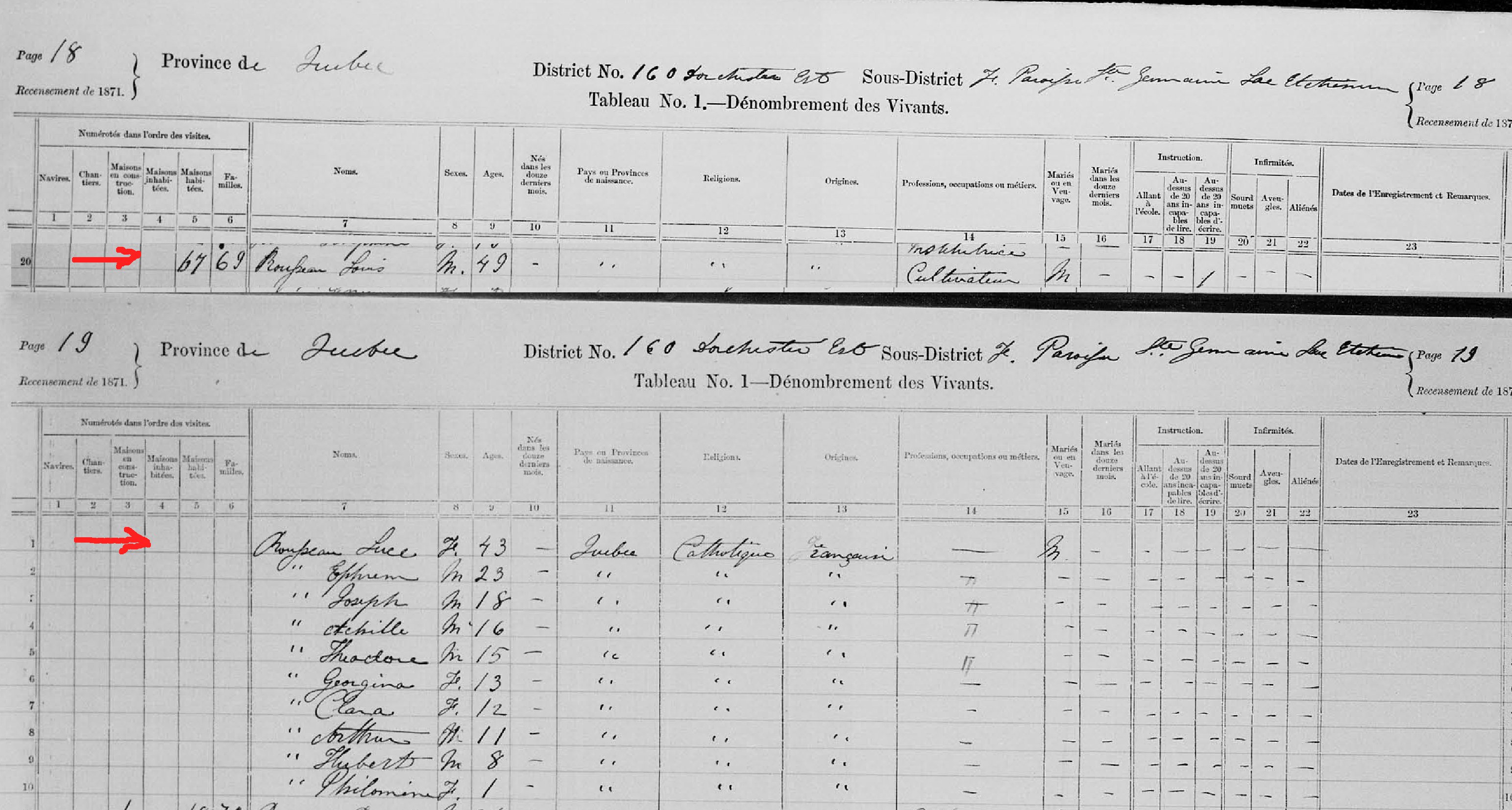
|
Summary information can then be extracted for each family member, for example, for Louis Rousseau one woud obtain:
| CENSUS of CANADA, 1871 | |
| Name: | Rousseau, Louis |
| Sex: | Male |
| Age: | 49 |
| Place of Birth: | Quebec |
| Religion: | Catholique |
| Marital Status: | Married |
| Province: | Quebec |
| District Name: | Dorchester East |
| District Number: | 160 |
| Sub-District Name: | Ste-Germaine du Lac-Etchemin |
| Sub-district Number: | f |
| Page: | 18 |
| Line Number: | 20 |
| Microfilm: | C-10359 |
| Reference: | RG31 - Statistics Canada |
SOME BRIEF COMMENTS are in order here:
Family name is obviously "still" Rousseau. It was not unitl the move to the USA that the name changed to Brooks
Louis' profession is listed as "cultivateur" which is french for "farmer".
This is the earliest appearance of the name HUBERT -- as in Hubert Rousseau -- for in the next 1880 US CENSUS "Hubert" and brother "John" are inadvertently combined and referred to as "John" Brooks with Hubert's birth year
One can safely assume from these dates that Louis Rousseau had been in Dorchester Québec from 1846 to 1871 and most probably till 1877 when he left for the US
As will be documented by US Immigration Records in the next SECTION, mother Luce Rousseau first left for the US (Grand Forks N.D.) in April 1876, followed in March of 1877 by son Hubert Rousseau, and then, finally, in April of 1877 Louis Rousseau left Dorchester Québec for Grand Forks.
As an editorial aside, there exists a Rousseau family -- Rene Rousseau and daughters -- living and working on Île d'Orléans to this day.
|
|
These descendants of Thomas Rousseau's 4th son Antoine (Jean-Baptiste's older brother) continue the Rousseau Butcher Shop tradition first started in 1853 by Firmin Rousseau.
(For further information concerning the family Butcher Business see
WEB NEWS ITEM REFERENCE ).
ALSO in the Ste. Pierre area of Île d'Orléans, just off the main island circle road of chemin du Bout-de-l'Ile is an Avenue Rousseau named in recognition of one of the island's founding families - the Rousseaus!

|
The North Dakota Pioneer Biography Files described further in the next section had accounts from both Tancrede and Alphonse Grégoire that briefly spoke about their lives back in Québec. This provides some insight into the life no doubt experienced by the neighboring Rousseau clan.
The following is an extract from these Pioneer Biographies.
Tancrede Grégoire
Tancrede Grégoire was born in St. Marie Parish, Beauce, Quebec, Canada to parents of French lineage, Gaspard Gréegoire and
Adele Philomene (Fannie) Marcoux Grégoire on Jan 6, 1859.
There being no public school in the community, Tancrede had very little chance to go to school. He says about one month was all the schooling he ever had. However he
learned to read and write in French.
When he was about 14 or 15, he went to work in a carriage maker's shop. He continued there until he came to Dakota, thus learning a valuable trade.
About a month before he left his Canadian home his mother died.
Alphonse Grégoire
Alphonse Grégoire was one of the younger ones of a family of 11 children born to Gaspard and Philomine Grégoire on their
farm about 1.5 miles from Ste. Marie in Beauce County of Québec Canada.
They were near enough to the border of Maine so that sometimes the men walked over into Maine to work in the hay fields during the season. This had been a timbered
country but it had been all cleared up before Mr. Gregoire's time except some timber lots where there were many large Ward Maple trees from which they made maple
sugar. Mr. Gregoire remembers gathering the sap and boiling it.
They were ten leagues (30 miles) south of Québec City. Mr. Gregoire's father and grandfather
had lived on the same farm, his father having been born there. His mother's family also lived in the same community.
Alphonse attended the rural school near their home 3 or 4 years, leaving school when he was about 14 years old, after which he worked for different neighbors.
Practically all farm work there was done by hand. The grain was cut with a cradle or hand hook and was thrashed with a flail or tramped out.
Mr. Gregoire says that they got almost no wages at all for their work in Québec.
Rosalie Marcoux Turcotte
See Newspaper article at bottom of previous section 2.4 on Rosalie Marcoux Turcotte that relates in detail early life in Québec. Very interesting!
| PREVIOUS PAGE | GO TO TOP OF PAGE FOR APPENDIX NAVIGATION MENU |
NEXT PAGE |
The Life and Times of Hubert Brooks M.C. C.D.